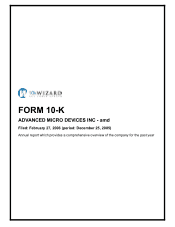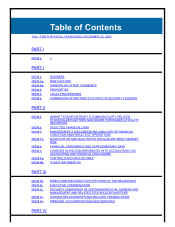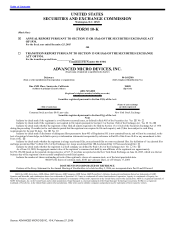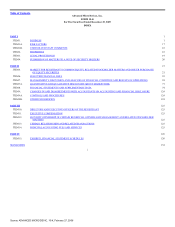AMD 2005 Annual Report Download - page 11
Download and view the complete annual report
Please find page 11 of the 2005 AMD annual report below. You can navigate through the pages in the report by either clicking on the pages listed below, or by using the keyword search tool below to find specific information within the annual report.
Table of Contents
operating systems, including Linux, Microsoft® Windows® and Solaris operating systems. In addition, these processors support HyperTransport™ technology,
which is a high-bandwidth communications interface we initially developed, that enables substantially higher performance. We designed our AMD64-based
processors to be fully compatible with the Microsoft Windows 64-bit operating system as well as other operating systems. We believe that the backward
compatibility of our AMD64-based processors will allow users to migrate more easily from current 32-bit operating systems and applications to 64-bit operating
systems and applications on a common hardware platform.
Chipsets. We also sell chipset products primarily to support certain models of our AMD Opteron processors and make available motherboard reference
design kits, designed to support our microprocessors for use in PCs and embedded products. A chipset provides the interface between all of a PCs subsystems
and sends data from the microprocessor to input, display and storage devices, such as the keyboard, mouse, monitor and hard drive. The primary reason we offer
these products to our customers is to provide them with a solution that will allow them to use our microprocessors and develop and introduce their products into
the market more quickly.
Memory Products
The Flash Memory Market
Flash memory is an important semiconductor component used in electronic devices such as mobile phones, digital cameras, DVD players, set top boxes,
MP3 players and automotive electronics such as navigation systems. Flash memory differs from other types of memory due to its ability to retain stored
information after power is turned off. Most electronic products use Flash memory to store important program instructions, known as code, as well as multimedia
content or other digital content known as data. Code storage allows the basic operating instructions, operating system software or program code to be retained,
which allows an electronic product to function, while data storage allows digital content, such as multimedia files, to be retained. For example, Flash memory in
camera phones retains the program code, which enables users to turn on and operate the phone, and also stores data such as digital photos.
The Flash memory market can be divided into three major categories based on application: wireless, embedded and removable storage. Portable,
battery-powered communications applications are categorized as “wireless.” Solid-state removable memory applications are categorized as “removable storage.”
All other applications are categorized as “embedded.” Applications within the wireless category include mobile phones and smart phones. Applications within
the removable storage category include USB drives and memory cards. Applications within the embedded category include consumer electronics, automotive
electronics, PC peripherals, networking and telecom equipment (excluding mobile phones) and industrial, medical and military products. Spansion participates in
the wireless and embedded categories of the NOR Flash memory market.
There are two major architectures of Flash memory in the market today: NOR Flash memory, which is used for code and data storage in mobile phones
and primarily for code storage in consumer electronics, and NAND Flash memory, which is primarily used for data storage in removable memory applications,
such as compact Flash cards and USB drives, and is increasingly being used in some high-end mobile phones and embedded applications. Within the Flash
memory market, Spansion sells NOR Flash memory products.
Flash Memory Products
Spansion’s Flash memory products encompass a broad spectrum of densities and features and are primarily designed to support code, or mixed code and
data storage applications in the wireless and embedded categories of the Flash memory market. Spansion’s products are used in mobile telephones, consumer
electronics, automotive electronics, networking equipment and other applications that require memory to be non-volatile and electrically rewritten.
6
Source: ADVANCED MICRO DEVIC, 10-K, February 27, 2006
























